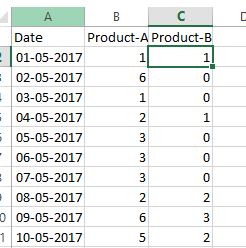基于R的多项先知预测
基于R的多项先知预测
提问于 2018-08-29 06:06:36
我是非常新的时间序列预测使用先知在R,我能够预测一个产品的价值使用先知。有任何方法,如果我可以使用循环生成预测使用先知为多种产品?下面的代码对于单个产品是非常好的,但是我试图为多个产品生成预测。
library(prophet)
df <- read.csv("Prophet.csv")
df$Date<-as.Date(as.character(df$Date), format = "%d-%m-%Y")
colnames(df) <- c("ds", "y")
m <- prophet(df)
future <- make_future_dataframe(m, periods = 40)
tail(future)
forecast <- predict(m, future)
write.csv(forecast[c('ds','yhat')],"Output_Prophet.csv")
tail(forecast[c('ds', 'yhat', 'yhat_lower', 'yhat_upper')])样本数据集:

回答 1
Stack Overflow用户
回答已采纳
发布于 2018-08-29 06:53:15
这可以通过使用来自lists包的map和purrr函数来实现。
让我们构建一些数据:
library(tidyverse) # contains also the purrr package
set.seed(123)
tb1 <- tibble(
ds = seq(as.Date("2018-01-01"), as.Date("2018-12-31"), by = "day"),
y = sample(365)
)
tb2 <- tibble(
ds = seq(as.Date("2018-01-01"), as.Date("2018-12-31"), by = "day"),
y = sample(365)
)
ts_list <- list(tb1, tb2) # two separate time series
# using this construct you could add more of course构建与预测
library(prophet)
m_list <- map(ts_list, prophet) # prophet call
future_list <- map(m_list, make_future_dataframe, periods = 40) # makes future obs
forecast_list <- map2(m_list, future_list, predict) # map2 because we have two inputs
# we can access everything we need like with any list object
head(forecast_list[[1]]$yhat) # forecasts for time series 1
[1] 179.5214 198.2375 182.7478 173.5096 163.1173 214.7773
head(forecast_list[[2]]$yhat) # forecast for time series 2
[1] 172.5096 155.8796 184.4423 133.0349 169.7688 135.2990更新(只是输入部分、构建部分和预测部分--它是相同的):
我创建了一个基于OP请求的新示例,基本上,您需要将所有内容再次放入list对象中:
# suppose you have a data frame like this:
set.seed(123)
tb1 <- tibble(
ds = seq(as.Date("2018-01-01"), as.Date("2018-12-31"), by = "day"),
productA = sample(365),
productB = sample(365)
)
head(tb1)
# A tibble: 6 x 3
ds productA productB
<date> <int> <int>
1 2018-01-01 105 287
2 2018-01-02 287 71
3 2018-01-03 149 7
4 2018-01-04 320 148
5 2018-01-05 340 175
6 2018-01-06 17 152
# with some dplyr and base R you can trasform each time series in a data frame within a list
ts_list <- tb1 %>%
gather("type", "y", -ds) %>%
split(.$type)
# this just removes the type column that we don't need anymore
ts_list <- lapply(ts_list, function(x) { x["type"] <- NULL; x })
# now you can continue just like above..页面原文内容由Stack Overflow提供。腾讯云小微IT领域专用引擎提供翻译支持
原文链接:
https://stackoverflow.com/questions/52070501
复制相关文章
相似问题

